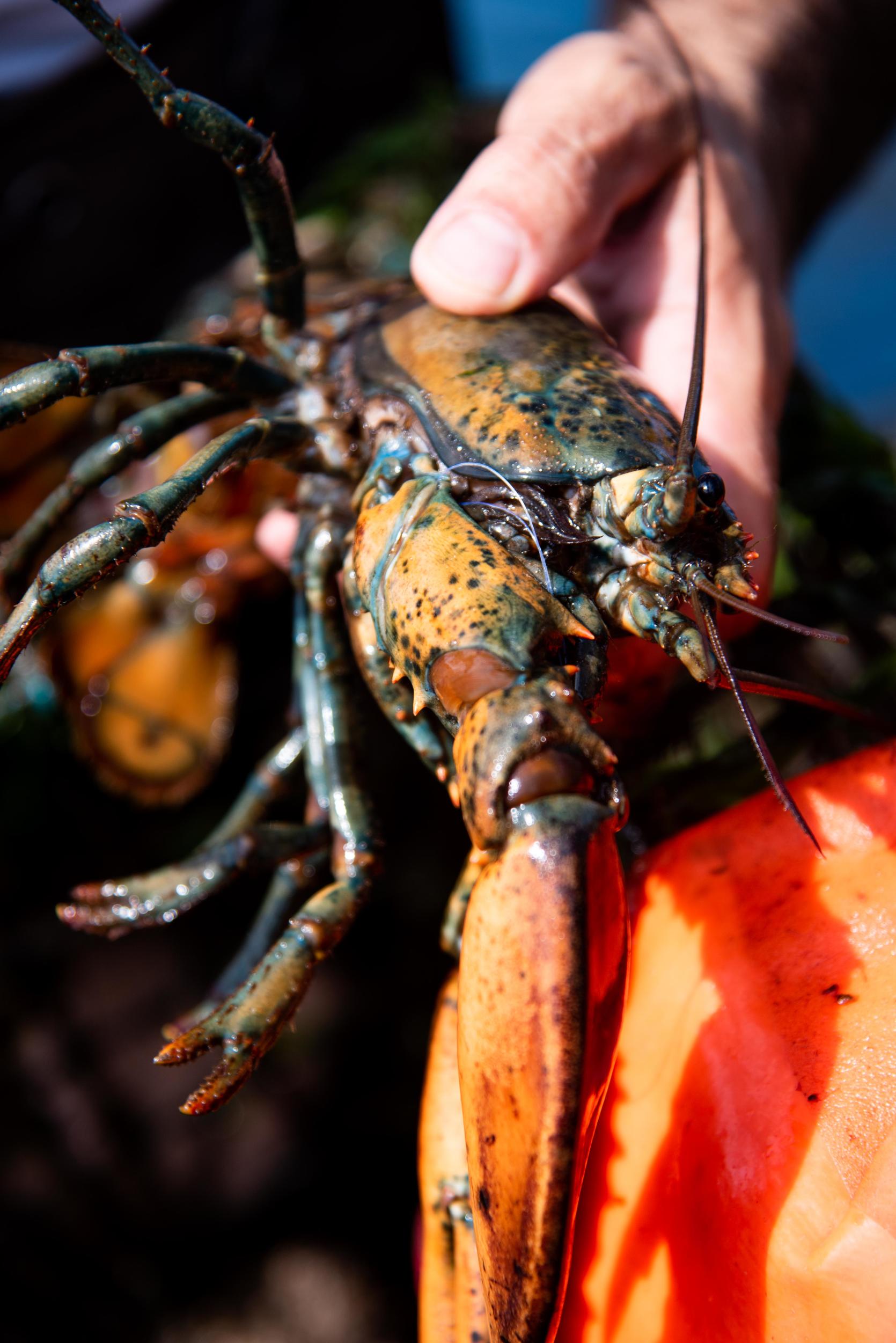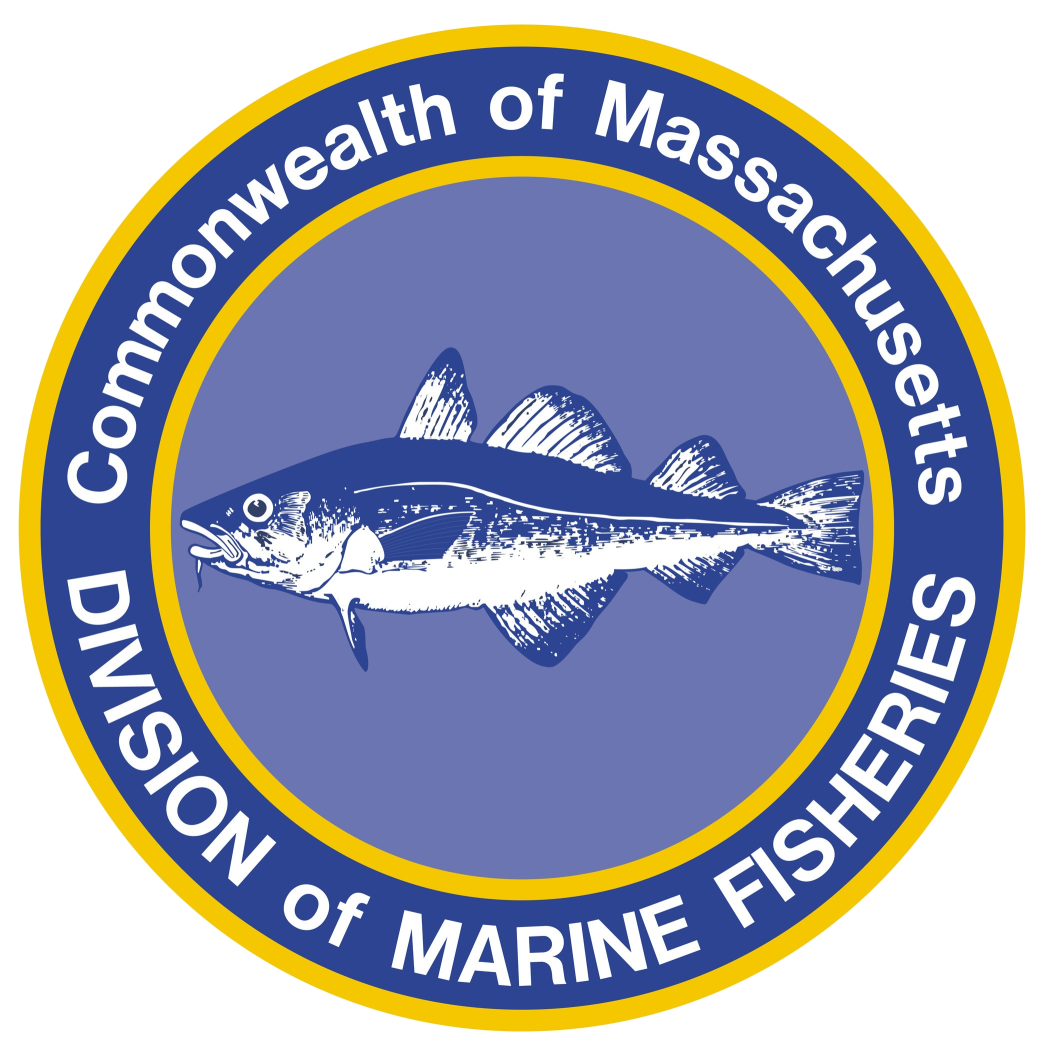- Division of Marine Fisheries

Dead lobsters, crabs, and fish reported
In September, DMF was contacted by the Massachusetts Lobstermen’s Association after several lobstermen observed an unusual occurrence in their traps. In portions of southern Cape Cod Bay, traps were coming up from the ocean floor containing dead lobsters, crabs, and finfish. All initial reports were from an area between Scorton Ledge and the mouth of Barnstable Harbor, at depths ranging from 30–70 ft of water. Individual fishermen’s counts of dead lobsters ranged from a dozen to several hundred within a fishing day.
DMF staff immediately interviewed fishermen in the area to narrow down the timing and location of the observed mortalities. The first known incident occurred on September 15 and 16, when a dragger hauled in dead scallops from an area slightly northeast of the dead lobster reports, in roughly 80 ft of water. The first observed incidence of dead lobsters occurred on September 20, off of Sandy Neck Beach, from traps fished in 40–60 ft water depth. Based on the information collected from fishermen, the affected area was the southern-most portion of Cape Cod Bay, generally from the Cape Cod Canal east to Barnstable Harbor, in water depths of approximately 30–80 ft. Species affected included lobsters, Jonah crabs, rock crabs, sea ravens, cunner, ocean pout, scallops, wrymouth, and sculpin.
To determine what caused these mortalities, DMF initiated a full-scale investigation of the event, including: using SCUBA divers to directly observe the bottom, retrieving a long-term bottom temperature monitor, collecting water quality samples in the affected area, observing the catch aboard commercial vessels, investigating the potential for a harmful algal bloom event, collating information on oceanographic conditions and weather patterns, collecting samples for pathology testing, and investigating the timing and location of pesticide applications for mosquito control.
Not enough oxygen!
In a joint effort with the Provincetown Center for Coastal Studies, we collected water quality data throughout the southern portion of Cape Cod Bay over the course of several days. We observed extremely low levels of dissolved oxygen (DO) in portions of the area at depths greater than 30 ft. Dissolved oxygen describes how much oxygen is available in the water for fish and crustaceans to breath. In many of the places we sampled, these levels were so low (hypoxic) that benthic fish and crustaceans could not survive. While mobile fish and invertebrates can detect these unfavorable conditions and will move to avoid hypoxic conditions, those animals in traps are continuously exposed to low DO may become lethargic and die.
Within days of the initial dead lobster reports, DMF biologists were able to sample aboard three different lobster fishing vessels working in the affected area. The biologists observed very low catch rates, with a few dead lobsters and several lethargic lobsters in traps within the affected area. Catch in traps immediately to the east of the affected area improved (both in quantity and in condition of the lobsters) over a relatively short distance. Some weak and lethargic lobsters improved dramatically after being placed in a tote without water or in the boat’s live well (supplied with flow-through water taken from the surface). This recovery supported our presumption that the lobsters had experienced hypoxia, since a return to well-oxygenated conditions resulted in obvious improvements.
DMF divers directly observed the ocean floor at two locations in southern Cape Cod Bay on September 25. The first site was in 25 ft of water on Scorton Ledge where DO levels were normal; they reported typical fish activity and spotted nothing unusual. The second site was in 55 ft of water north of Scorton Ledge where DO levels were severely hypoxic. At this site, DMF divers saw a few dead crabs and fish on the bottom, as well as some very lethargic-looking lobsters in traps. The divers did not observe numerous dead animals, nor did DMF receive any reports of dead animals washing ashore. Taken together, this suggested that many animals were able to avoid the area as conditions became unfavorable; however, those animals stuck in traps were more vulnerable.
Why did the bottom waters become hypoxic?
For most of the year, waters in Massachusetts Bay and Cape Cod Bay are exchanged due to patterns in regional ocean currents. However, in the late summer and early fall water exchange between Cape Cod Bay and Massachusetts Bay becomes reduced due to seasonal changes in those circulation patterns, isolating Cape Cod Bay. At this time of year the waters in Cape Cod Bay also tend to be stratified (layered) with warm waters at the surface and cooler waters at depth. Surface waters in early August of this year were unusually warm, setting up a very strong stratification which acts something like a barrier keeping the cooler, denser bottom waters from mixing with the more oxygen-rich surface waters. The isolation of Cape Cod Bay and strong stratification led to an accumulation of nutrients and organic matter in bottom waters. As the organic matter decays, oxygen is depleted, resulting in an annual decline of DO during the late summer and early fall. This annual decline of DO has been routinely documented by various groups who monitor water quality in Cape Cod Bay, but never to the extent of the values observed this year.
Usually, the onset of stormy weather in the fall breaks down the stratification and alleviates the low DO conditions in bottom waters. As the sea surface waters cool and the wind and waves associated with fall storms persist, surface waters begin to mix down, equalizing the temperatures and oxygen levels between the surface and bottom waters. This normally starts to happen around the middle of September but timing varies from year to year. This year, most of September was relatively calm with wave heights generally less than 3 ft, further contributing to the persistent stratification. It wasn’t until early October that we finally had storms strong enough to mix the oxygenated surface waters down. Data loggers that DMF deployed on October 2 were able to document the breakdown of stratification and rebound of DO in the affected area on October 4, coinciding with a windstorm that produced 4 to 7-ft seas for nearly 24 hours. This event was followed closely by another strong wind/sea event on October 9–12.
Mosquito control programs were not the culprit
As part of our investigation, DMF staff collected information on mosquito control and spraying activities from Middlesex, Norfolk, Boston, Suffolk, Bristol, Plymouth, and Barnstable Counties to investigate any potential role these control programs may have played in the observed mortalities in Cape Cod Bay. The timing and locations of the spray activities, along with the rapid breakdown of the products used left little to no opportunity for the pesticides to have reached lobsters in Cape Cod Bay. Additionally, there were no reports of fish kills or dead marsh animals along any of the rivers, streams, or tidal marshes leading from sprayed areas to Cape Cod Bay, nor were there reports of dead marine life in depths shallower than 30 ft along the immediate shoreline, which would have experienced the first and least diluted exposure, if any. There is no evidence to suggest that the mosquito control programs were related to the observed lobster and fish mortalities in southern Cape Cod Bay.
Conclusions
The localized lobster and finfish mortality event observed in the fall of 2019 in the southern portion of Cape Cod Bay was caused by extremely low dissolved oxygen (DO) in bottom waters. While low DO values have been recorded in the past, to our knowledge this is the first time that levels have deteriorated to the point of severe hypoxia.
The severely hypoxic conditions resulted in the death of lobsters and other benthic animals that were unable to move away from the deteriorating conditions. We expect that most mobile benthic animals left the area to avoid the hypoxic conditions. Based on diver observations and there being no reports of carcasses washing ashore, there is no reason to believe that there were large numbers of dead lobsters anywhere other than those trapped in gear.
Massachusetts’ heavily populated coastline and upstream urban environments will continue to result in downstream accumulation of nutrients and organic material in the waters of Cape Cod Bay. Decomposition of organic materials on the seafloor depletes oxygen from bottom waters and, under highly stratified conditions, the oxygen-rich surface waters do not mix down to replenish bottom waters. With changing climate conditions, increasing sea surface temperatures may strengthen water column stratification so it is reasonable to expect that southern Cape Cod Bay will experience similar hypoxic events in future years.
During our investigations into this event, DMF partnered with the Provincetown Center for Coastal Studies and formed collaborative relationships with oceanographers at the Woods Hole Oceanographic Institution. We will continue to foster these relationships and work towards monitoring and understanding conditions in Cape Cod Bay. The cooperation and commitment from the Massachusetts Lobstermen’s Association and local industry members affected by the mortality event were also vital to our work in documenting and understanding this event. Hopefully, with increased monitoring efforts and continued collaboration by everyone involved, we will be able to predict future events and provide industry members with timely forewarning, allowing them to move gear away from vulnerable areas of the Bay. This will help avoid not only financial losses but also inadvertent mortalities of fish and invertebrates trapped in the gear. Increased monitoring of bottom water quality in Cape Cod Bay will also provide additional data to oceanographers working to understand the seasonal dynamics of the Bay.
By Tracy Pugh, PhD, Invertebrate Fisheries Project Leader, Kelly Whitmore, Invertebrate Fisheries Biologist, and Steve Wilcox, Invertebrate Fisheries Biologist
